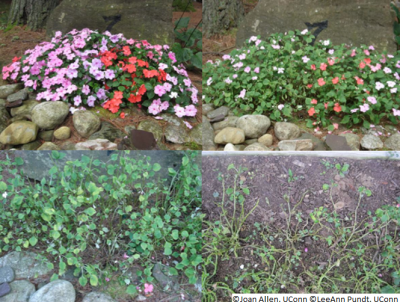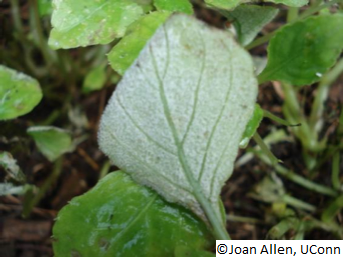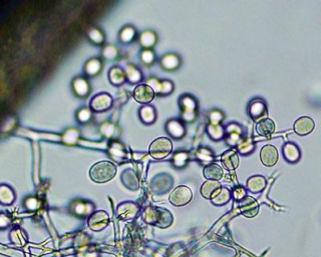Background
Impatiens downy mildew is a new disease for Connecticut gardens. It is caused by a fungus-like pathogen (Plasmopara obducens) and was first observed on garden impatiens (Impatiens walleriana) in the United Kingdom in 2002. Prior to that, it was identified as early as 1897 on wild impatiens (jewelweed) in Vermont. In 2011, there were outbreaks of this disease in many states including CA, IL, IN, NY, MA, MN, and WI. In January 2012, it was confirmed on plants in the landscape in Florida. During the 2012 growing season, impatiens downy mildew has been widespread in over 30 eastern states including Connecticut. The dramatic outbreaks of this disease have not been as widespread since 2012. In 2014, it was found in 20 states.
Host Plants
Susceptible hosts include standard garden impatiens, double impatiens and mini-impatiens and any hybrids of I. walleriana. Although balsam or garden balsam (Impatiens balsamina) is also susceptible, the symptoms primarily include yellow leaf spots. Fortunately, New Guinea impatiens (Impatiens hawkeri) types are not susceptible to this disease nor are other shade loving bedding plants.
Symptoms
Early symptoms include yellowing or yellow stippling of the leaves (resembling spider mite injury (which is not common on garden impatiens) or lack of fertilizer) and downward cupping of upper leaves giving the appearance that plants need to be watered (Figure 1). As disease progresses, flowers and leaves drop, eventually leaving bare stems with a few small leaves at the top. Finally, the stems completely collapse and the plant dies. After heavy rains, leaves may have a water-soaked appearance, resembling frost injury. Plants infected when young will be stunted.

A progression of symptoms is shown in below.

How it spreads
During humid or rainy weather, a white coating of spores will be produced on the lower surface of some leaves. Turn over the leaves to look for the white coating of spores; not all leaves will have this. These spores (Figures 3 and 4) are spread by wind, wind-driven rain, and splashing water. Cool night temperatures (58º to 62̊ºF) which encourage heavy dews are ideal for disease development, even if it is hot and dry during the day. New infections occur when leaves stay moist for a few hours. Downy mildew tends to be worse in very dense plantings, where there is overhead irrigation and areas where leaves stay wet for extended periods of time. New infections develop as the short-lived spores are spread by water splash for short distances or by wind currents for longer distances. Another type of spore, a resting or survival spore (called an oospore), is produced within infected plants just before they die. For this reason, it is important to remove infected plants from garden beds as soon as you see them. Oospores can survive in the soil through the winter and can cause new infections of garden impatiens the following year. There are many different types of downy mildew and they tend to be host specific, so the downy mildew that affects garden impatiens will not spread to coleus, basil or sunflowers.


Management
Current management recommendations are focused on disease prevention. Once plants are infected, they will not recover.
- Infected plants should be removed (including plants, leaf debris and roots), bagged and disposed of immediately.
- Do not compost diseased plant material! If infected plants are left in the garden or compost pile, there is a high risk that the fungal spores will overwinter in the soil and affect future plantings. Infected plants should be removed (including plants, leaf debris and roots), bagged and disposed of immediately. Do not compost diseased plant material! If infected plants are left in the garden or compost pile, there is a high risk that the fungal spores will overwinter in the soil and affect future plantings.
- If you have had impatiens downy mildew in your garden, use alternative non-host bedding plants for the next 1-2 seasons.
- Downy mildew resistant garden impatiens include the Beacon impatiens and Imara XDR series.
- Gardeners can safely plant New Guinea impatiens (Impatiens hawkeri), as well as hybrids such as SunPatiens® and the new hybrid Bounce™ that are resistant to impatiens downy mildew.
- Suggested alternative plants for shady beds include begonia, Coleus, Torenia, Lobelia, and others. There are also many shade-loving foliage plants and perennials that can be planted your garden.
Despite good cultural practices, pests and diseases at times may appear. Chemical control should be used only after all other methods have failed.
For pesticide information or other questions please call toll free: 877-486-6271.
J. Allen and L. Pundt, September 2012